
This trip was sponsored by Tourism Nova Scotia. All opinions, as always, are my own.
It’s been a long time – years, in fact! – since I’ve taken any kind of major holiday, especially a solo one. But with my son now two years old, I felt a bit more comfortable travelling away from home for a few days. And when I thought about where I wanted to go, one place kept popping into my mind: Halifax, Nova Scotia.
While I was born and raised in Winnipeg, Manitoba, and live here once again, part of my heart will always lie in Nova Scotia. I moved there at 18 and attended Acadia University in Wolfville before transferring to Dalhousie University in Halifax, living in Nova Scotia for a total of four years. I loved my life there; it was filled with new friends, new experiences, and lots of walks along the ocean. Other than a quick weekend trip back in my mid-20s, it had been well over a decade since I had stepped foot in this beautiful Atlantic province.
When I realized that a partnership with Tourism Nova Scotia would work out this summer, then, I was over the moon. I was so excited to return to this city I once loved so much, but this time return as a tourist. I knew that I had overlooked so many amazing sightseeing spots in Halifax when I lived there, as I was so consumed with university, work, and friends.
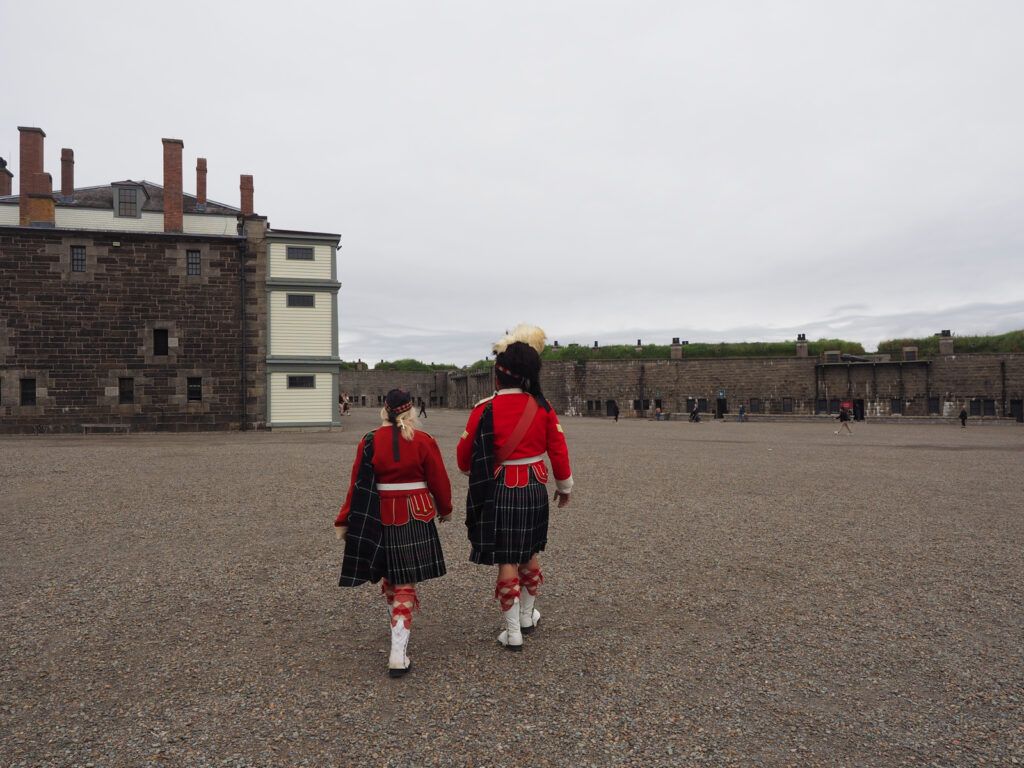
As someone who loves to learn about the history of a place – of the who and the why a place is what it is – I knew my focus was going to be on that. And Nova Scotia is filled with history; in fact, despite it being the second-smallest province by land size, it has 13 national historic sites!
On top of that, Halifax is home to the Halifax Defence Complex, a collection of five forts that were crucial overseas naval stations for the British Empire. They helped protect the Halifax Harbour from the late 1700s all the way to World War II. Despite not knowing much about this side of Halifax’s history, I was able to visit all five, and – history buff or not – I believe that they’re all absolutely worthy of a visit when you’re in Halifax.

I’ve outlined the five national historic sites that make up the Halifax Defence Complex below, but I’ve also included a section about some other spots to visit to round out your historical Halifax itinerary. You’ll also find a few details about where to stay, where to eat, and so on!
Without further ado, here are my recommendations for a historical itinerary of Halifax, focusing on visiting the Halifax Defence Complex.
How to Visit the Five Main Sites of the Halifax Defence Complex
Halifax Citadel National Historic Site
Location: 5425 Sackville St (on Citadel Hill)
Hours: Daily from 9 a.m. to 5 p.m. (services change with the seasons)
Admission: Click here
Let’s start with perhaps the most famous national historic site in Halifax! The Halifax Citadel National Historic Site, often just referred to as “the Citadel,” is the spot you’ll hear about when you hear people talking about sightseeing in Halifax.
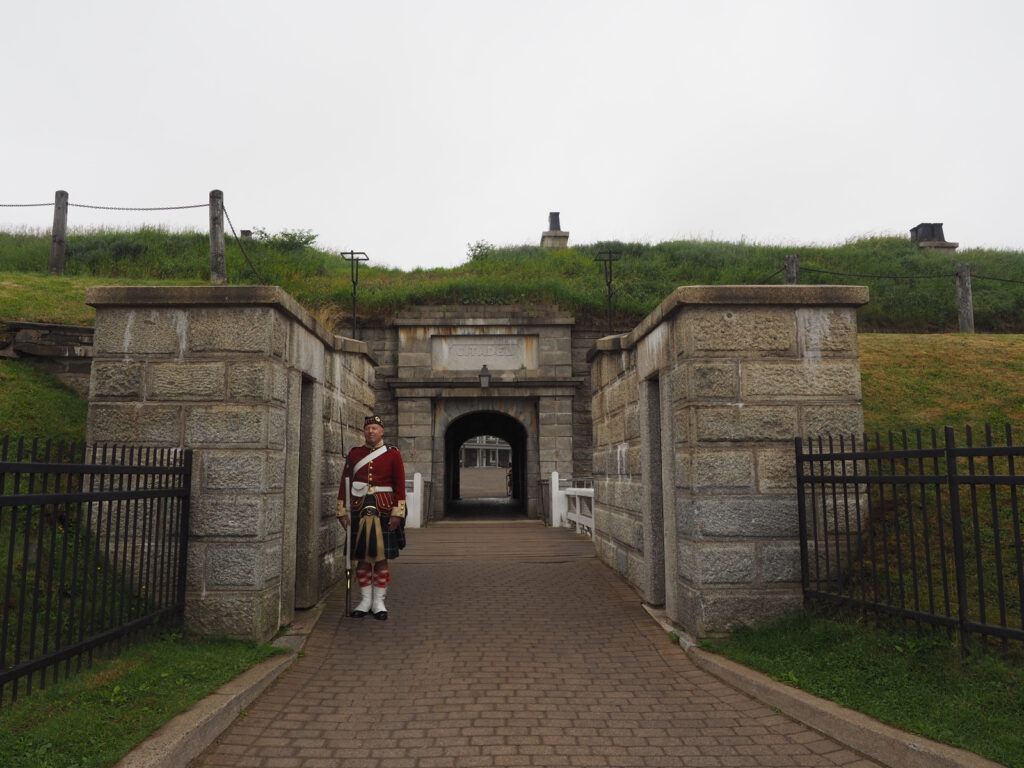
Found in the heart of downtown Halifax, this hilltop fort offers incredible views over the Halifax Harbour. With a history that dates back to 1749, Parks Canada restored the fort to what it would have looked like in the Victorian Era in the mid-1800s. The present Citadel, completed in 1856, is officially called Fort George and is the fourth in a series of forts to sit atop the hill watching over the city.
Although I list all of the many things to do at the Citadel below, my top recommendation for history buffs is to book the “Soldier for a Day” experience. This three-hour-long immersion allows you to experience exactly what it was like as a new inductee as a 78th Highlander in the 19th century.
I had a fantastic time with Sergeant Andrew Crawley (who gave me an overview of the history of the Citadel) and Corporal Sarah McPhee (who taught me how to fire a 19th-century rifle). One of the highlights of the experience was working with Kerry and Annamarie in the costuming department; I thought I’d be given a jacket and sent on my way, but they fitted me for an authentic uniform from head to toe, hat, kilt, and boots included! It was an incredibly fun way to spend an afternoon and definitely one of the more memorable aspects of my trip to Halifax.
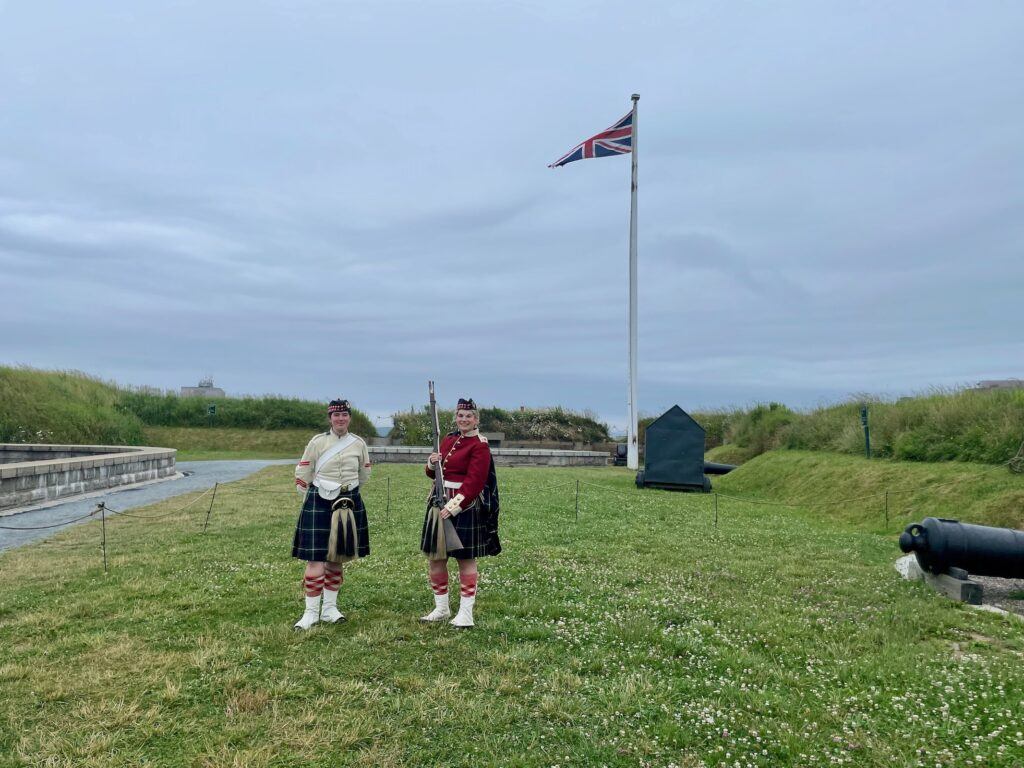
At the Citadel, you’ll find numerous original buildings as well as costumed staff that give you a glimpse of what life was like in the 19th century here. Because there are so many things to do, I’d recommend leaving at least half a day to explore. Activities at the Citadel include:
- Take a guided tour to learn as much as possible about the Citadel. Tours are offered from May through October throughout the day and are included with your admission. You can find the schedule at the Visitor Center.
- Listen for the noon gun: A tradition since 1857, the 3rd Brigade Royal Artillery fires the gun daily to announce the noon hour. In fact, you can hear it across the city!
- Explore the Army Museum Halifax Citadel, which tells the compelling stories of Nova Scotian soldiers.
- Watch the sentry change every hour at the front gate.
- Enjoy the gift shop, where you’ll find many beautiful souvenirs to take home.
- Join a distillery tour as you learn about the history of alcohol in the British military. Tours are held year-round; you can find more information about upcoming events here.
- Indulge in a traditional meal from the Halifax Citadel Coffee Bar. Historic menu options include ploughman’s lunch, soldiers’ stew, Luski Mi’kmaw bannock bread, and more. You can also enjoy a Parks Canada Perfect Picnic, as there are plenty of places in and around the Citadel to have a beautiful picnic! No pre-ordering is required; you can order at the coffee shop.
- Fire an authentic Snider-Enfield rifle just as they did in 1869! Available for people over the age of 16. Find out more here.
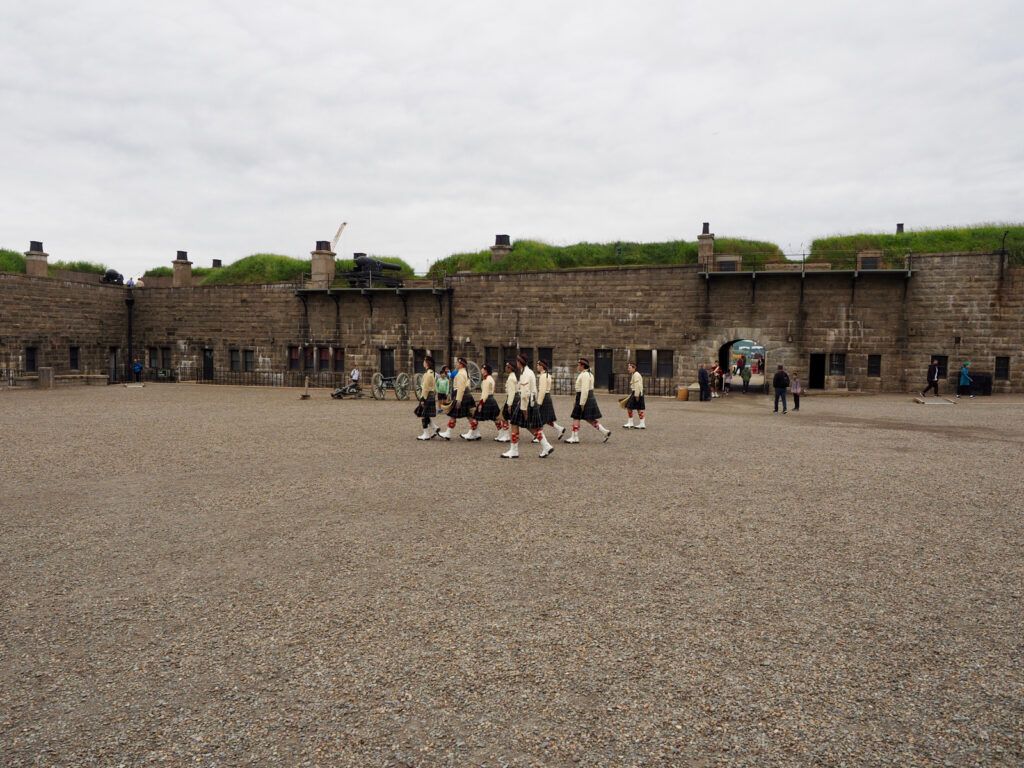
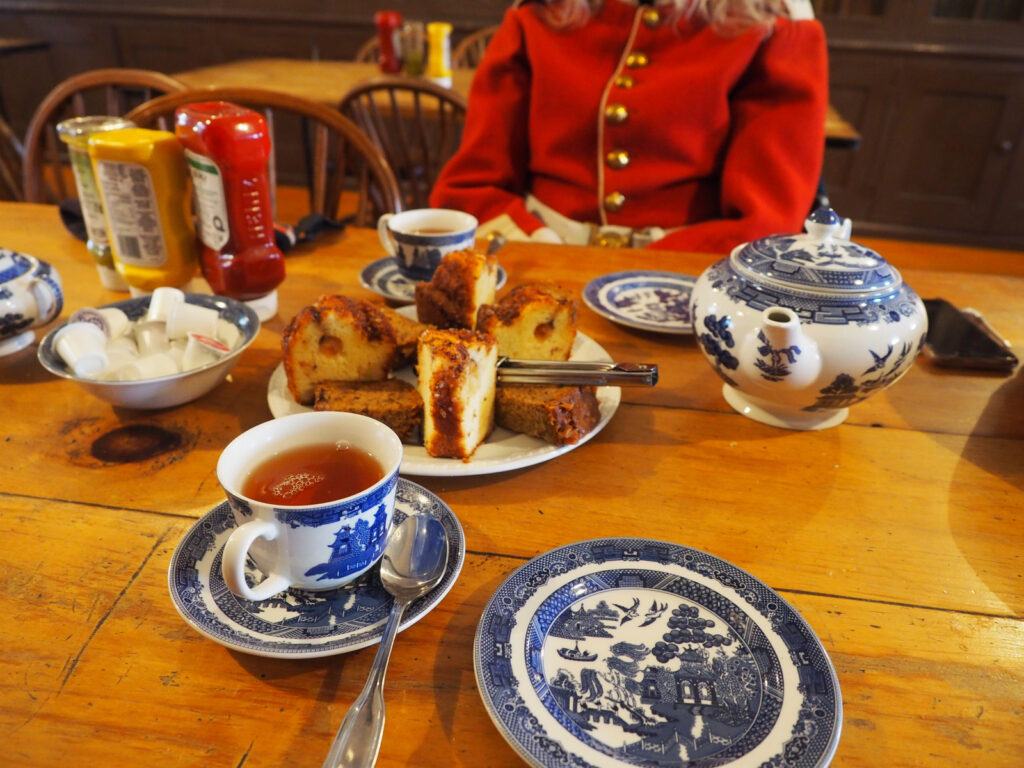
You can also join a ghost tour at the Citadel. This tour tells you about a few spooky stories over the years as well as some conspiracies about the fort (is there really a tunnel all the way to Georges Island from the Citadel?!). You can find out more here and book your tickets on Eventbrite; tickets sell out quickly, so book ahead as soon as possible. As far as I know, ghost tours are only available on Thursday, Friday, and Saturday evenings in the summertime/peak season.
Fort McNab National Historic Site
Location: McNabs Island (only accessible by boat)
Hours: Open year-round, but guided tours are only available on limited days in July and August
Admission: Zero admission to actually visit the island, but you need to have a way there. Guided tours through the Friends of McNabs Island Society are recommended (more on that below)

Fort McNab National Historic Site is perhaps the most challenging site to visit of the five in the Halifax Defense Complex, but it is also my favourite one to visit. While difficult to get to, I promise it is worth it!
Fort McNab is found on McNabs Island, which is accessible by commercial or private boat from Halifax, Dartmouth, Eastern Passage, and Northwest Arm; it takes around 30 minutes from Halifax, and you can check out some boat operators here. I can’t speak to the experience of visiting by way of a private charter or your own boat, but I can wholeheartedly recommend checking out The Friends of McNabs Island Society, who run guided tours on limited days in July and August. This means visiting McNabs Island takes some planning and booking in advance, but again, it’s 100% worth it.

Things to do on McNabs Island with a guided tour include:
- Learn about the significance of the island to the Mi’kmaw First Nations, the early French settlers, and the British, who built several forts on the island to protect the Port of Halifax (including Fort McNab National Historic Site)
- Visit Fort McNab and learn how this historic hilltop fort was created
- Admire the panoramic views over the ocean from Fort McNab
- Walk around peaceful McNabs Pond
- Visit the English Gardens, the ruins of the A. J. Davis Bottling Plant, and the
Teahouse Outdoor Education Centre - Learn about the changing shape of the island as beaches and coves change over the years
- Eat lunch on the beach with the ocean as your view
- Stroll along Maughers Beach and watch the tide roll in
- Enjoy this beautiful piece of nature that feels far removed from the hustle and bustle of Halifax (even though it’s only a short boat ride away!)


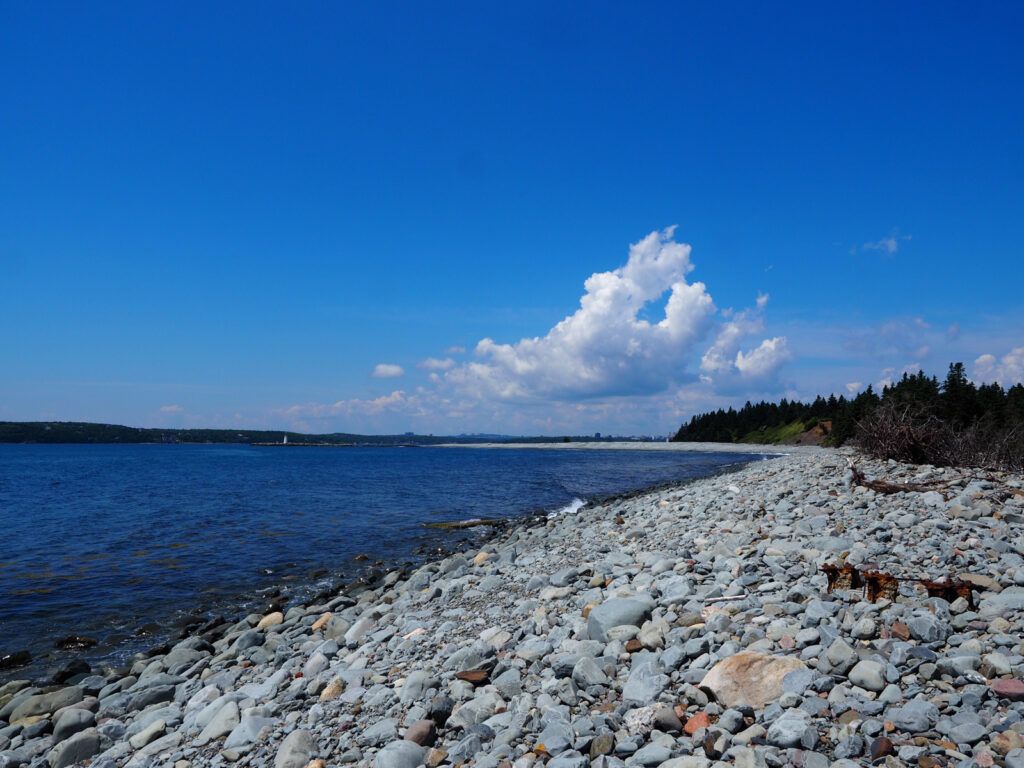
I am planning on writing an entire post dedicated to my time on McNabs Island because it was so special. I will link that here when it is live!
Georges Island National Historic Site
Location: In the middle of the Halifax Harbour (only accessible by boat). If travelling there with Ambassatours Gray Line, the ferry is boarded at Cable Wharf, 1751 Lower Water Street.
Hours: Specific days and times from June until October (click here for more information)
Admission: Fees vary. If booking through the Ambassatours Gray Line (which is what I recommend; more below), admission is included.
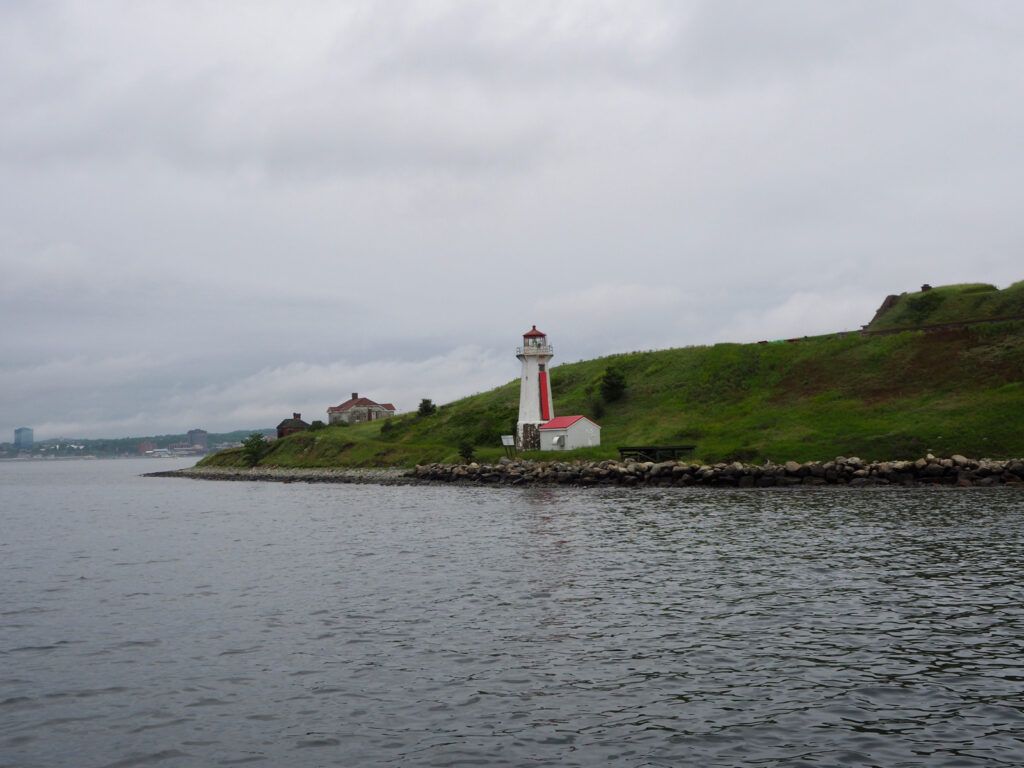
If you’ve spent any time on the Halifax Waterfront, you’re bound to have noticed Georges Island. The largest island to sit entirely within the Halifax Harbour, it only opened to the public in 2020. Since then, it has become quite a major tourist attraction in the warmer months!
Only accessible by boat and only open a few days per week in summer, a visit to Georges Island requires some planning, but it is absolutely worth it! I recommend booking with Ambassatours Gray Line, as they will cover your ferry ticket and admission; advance booking is required to guarantee your journey. You can book online or in person at the kiosk at the Halifax Waterfront. Otherwise, you can travel to the island by private boat, canoe, or kayak.

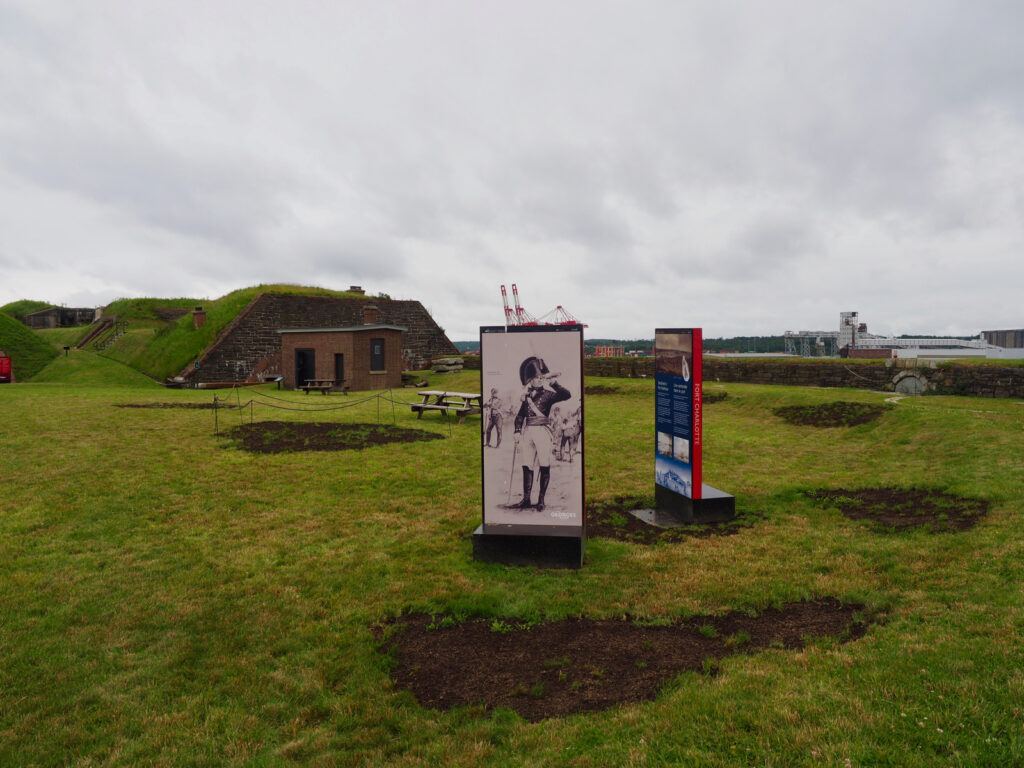
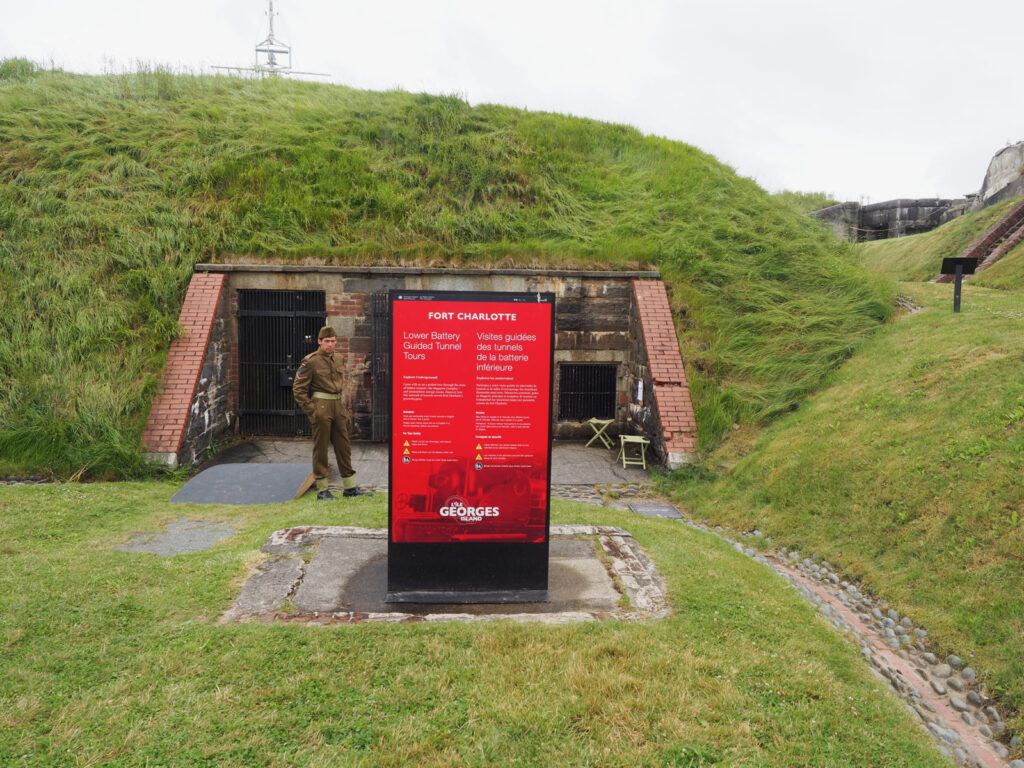
Called Kjipuktuk or “The Great Harbour” by the Mi’kmaq, one of the big highlights of visiting Georges Island is the view of Halifax. On your boat ride out to the island with Ambassatours Gray Line, you’ll also get a “scenic boat tour” around the island, weather permitting, so that you can see all sides of the small island.
On Georges Island itself, there is much to explore, so I recommend planning for at least a few hours here. Walk around the island and learn more about Fort Charlotte, including its time as as an Acadian internment camp and a prison. There are also free guided tunnel tours that run every 20 minutes.

Another recommendation is to pre-purchase a Parks Canada Perfect Picnic. It was such a memorable experience to eat a lobster roll on this historic island… with some of the best views of Halifax to boot!
If you haven’t been to Georges Island National Historic Site, I highly recommend it. It was by far one of my favourite experiences in Halifax, especially for the views of the city.
York Redoubt National Historic Site
Location: 300 Fergusons Cove Rd, Fergusons Cove (outside of Halifax)
Hours: Daily 8 a.m. to 8 p.m.
Admission: Free

Found about a twenty-minute drive outside of Halifax, York Redoubt National Historic Site was constructed in 1793 and helped to protect and defend the Halifax Harbour. Of all the spots I visited in Nova Scotia in order to learn more about its history, York Redoubt had the fewest tourists, but it’s a lovely place to go for a stroll; the views over the entrance to the Halifax Harbour are phenomenal!
Once at York Redoubt, you can walk around the site at your leisure. There are quite a few interpretive panels that explain the importance of the site, from its original batteries in 1793 to its significance in the 19th century to its use during WW1. In fact, it was in military use until 1956!
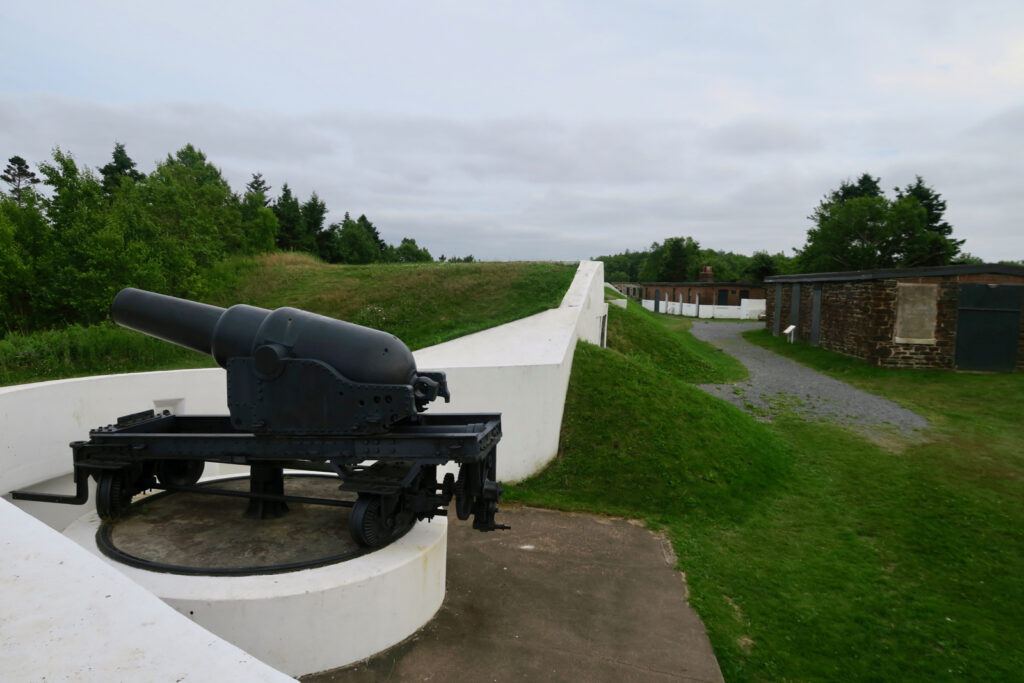

While I was there, I saw a few other people walking around the site, but most looked like locals (many were there to walk their dogs, which are allowed on-leash). I found my visit there very peaceful; it was lovely to be in nature and the view out over the Atlantic was absolutely stunning. I also really enjoyed my drive there and back, as you pass by many small harbours.
This site does require a bit more planning – you’ll need a rental car to get there or would most likely have to pre-arrange transportation – but it’s a real treat to visit for those who want to learn as much about Halifax’s history as possible.
Prince of Wales Tower National Historic Site
Location: Inside Point Pleasant Park (which is found at the southern tip of the Halifax peninsula, about a 10-15 minute drive from downtown)
Hours: Park hours are 5 a.m. to 10 p.m.
Admission: Free
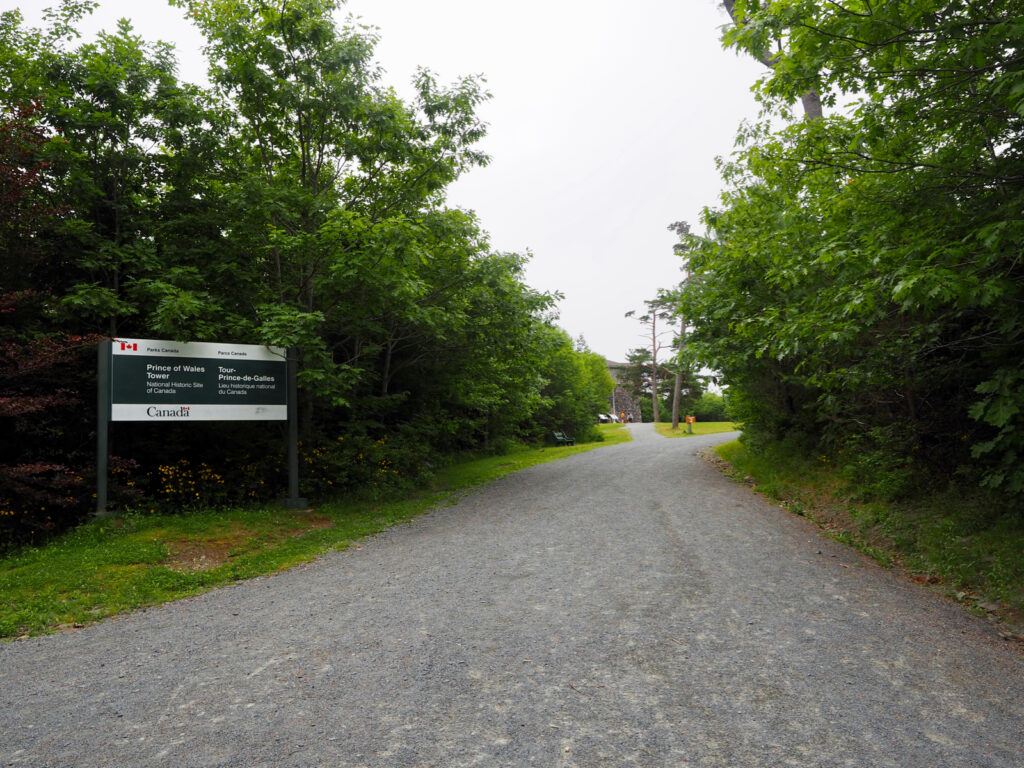
The Prince of Wales Tower National Historic Site is found inside beautiful Point Pleasant Park, about a ten-minute walk from the parking lot. There are lots of signposts around the park, so I found it very easy to find. I definitely recommend a visit as the park itself is gorgeous; you’d never know you were in a big city while walking on its tree-lined paths.
The Prince of Wales Tower is significant because it was the first Martello tower built in North America. Originating in Corsica, the British Empire adopted the Martello design and built Martello towers around the world. All told, there were 15 Martello towers built in Canada between 1796 and 1870, but only 11 still stand.
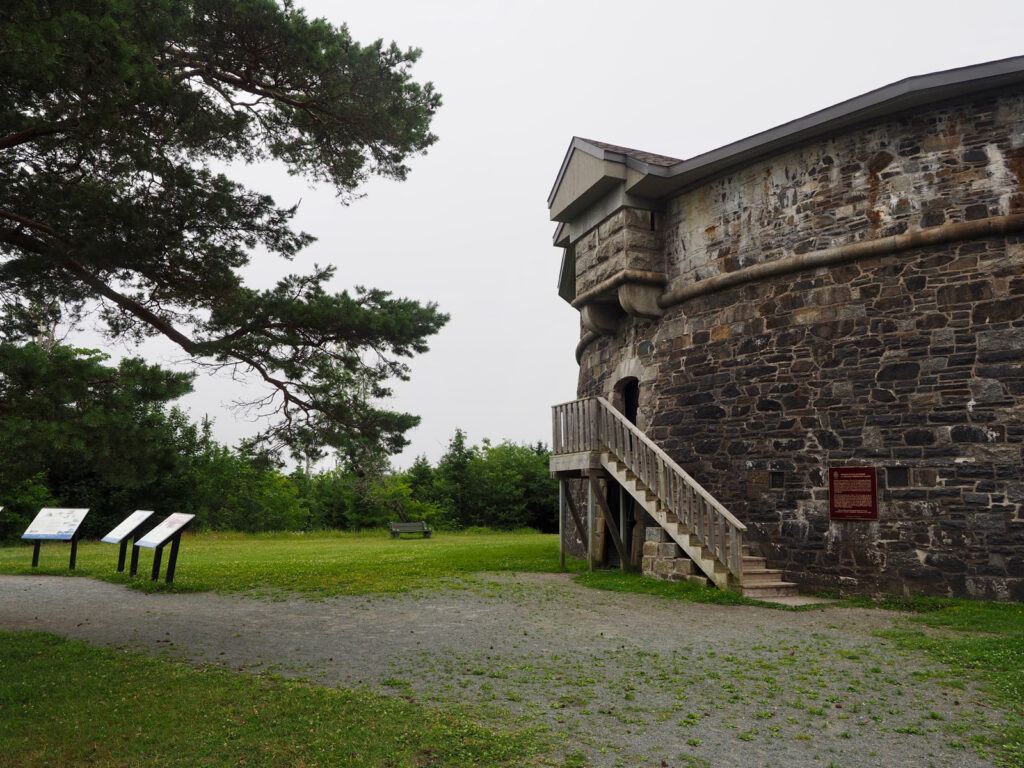
Originally built to protect British sea batteries from a French landward attack, the tower was part of a series of forts in the park. These Point Pleasant forts formed the first line of the Halifax Harbour defences and were in use until the late 19th century. Today, the tower and the ruins of the other forts in the park serve as a silent history of life in the 1700s and 1800s.
Enjoy walking in the park, reading the interpretive signs, and viewing this important piece of the Halifax Defence Complex!
Other Historical Spots in Halifax
Harbour Hopper
If you want a general overview of Halifax and really be able to orient yourself in the city, I recommend a Harbour Hopper tour. Not only are the tours fun – you get to travel by land and by sea in the same vehicle! – you get great views of the Halifax Harbour, the Citadel, downtown Halifax, and more.
I started my time in Halifax with a Harbour Hopper tour, and I’m so glad I did; it helped me get my bearings on where everything is in the city and gave me a nice overview of its history.

Canadian Museum of Immigration at Pier 21
The Canadian Museum of Immigration at Pier 21 shares the ongoing story of immigration to Canada, from past to present and from coast to coast to coast. What’s even more amazing about this museum is that it is located at Pier 21, a national historic site at the Halifax seaport, where nearly one million immigrants landed in Canada from 1928 to 1971.
I spent about an hour and a half wandering around the exhibits on my own, but you can also join free tours to learn as much as possible about the museum’s powerful history.

Art Gallery of Nova Scotia
Found conveniently on Hollis Street in downtown Halifax, the Art Gallery of Nova Scotia is a fantastic addition to your historical Halifax itinerary. With many rotating exhibits on display, the biggest draw – at least in my opinion – is the Maud Lewis Gallery, where you can learn more about this Nova Scotian artist’s art and legacy. In fact, her largest artwork – the house she lived in for over 30 years – is on display here, and is worth a visit to the gallery alone!
Also: the art gallery’s gift shop is the perfect place to buy a few Nova Scotia souvenirs. Trust me: I bought a lot, hah.
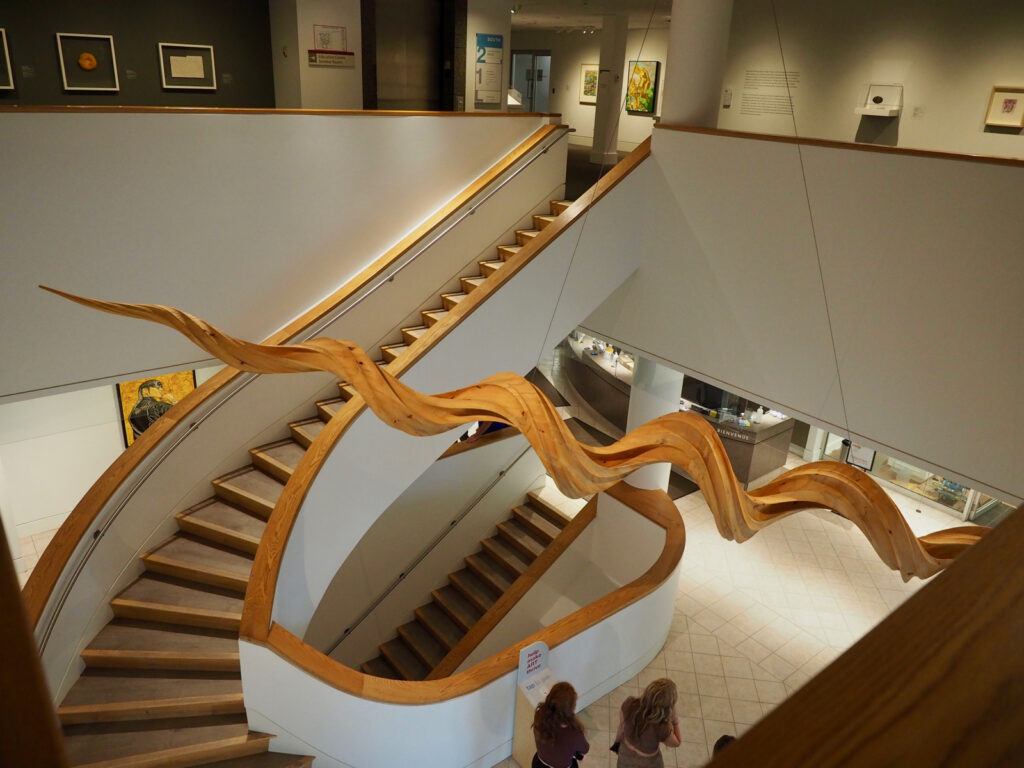
Maritime Museum of the Atlantic
The Maritime Museum of the Atlantic is found conveniently in downtown Halifax; you’ll see it if you walk along the Halifax Waterfront. Not only the oldest and largest maritime museum in Canada, it’s a great place to start when learning about Nova Scotia’s marine history, including the tragic Halifax Explosion of 1917 as well as Nova Scotia’s role in the aftermath of the Titanic disaster.

Halifax Waterfront
If you spend any time in Halifax, chances are you’ll spend some time at the Halifax Waterfront. With one of the world’s longest urban boardwalks – four kilometres in total! – there is a lot to do and see along the water. You’ll find a few of the attractions I’ve listed along the way (including the Canadian Museum of Immigration at Pier 21 and the Maritime Museum of the Atlantic), along with plenty of shops, restaurants, kiosks, art displays, and more. It’s also a great spot to view Dartmouth across the harbour as well as Georges Island National Historic Site.
There’s also the Halifax Seaport Market on Saturdays and Sundays, which is the oldest continuously operating farmers’ market in North America.
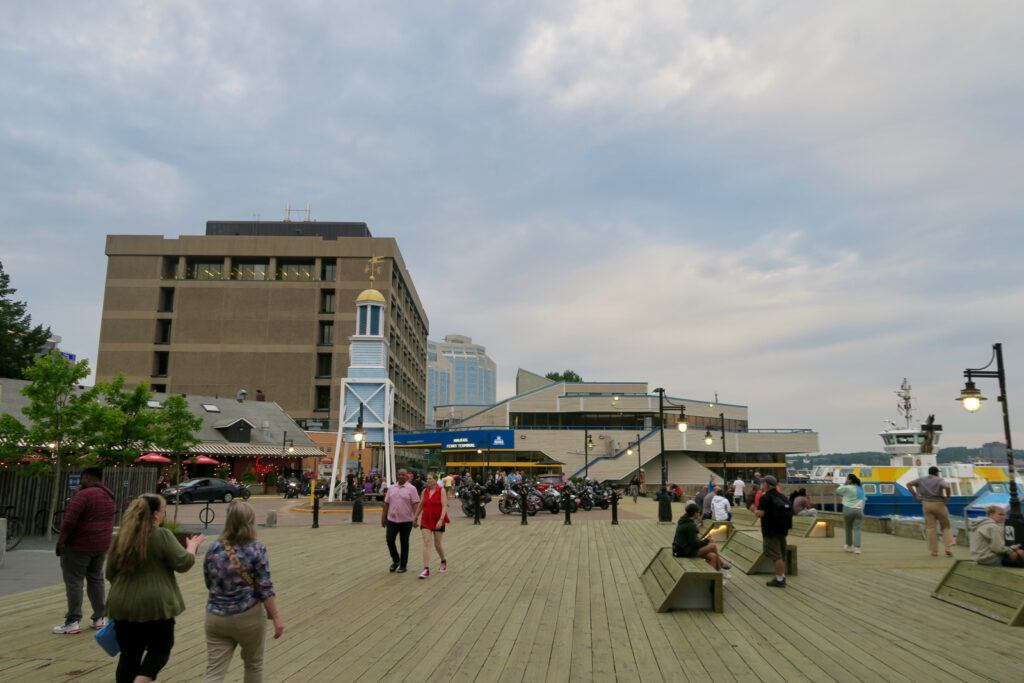
Want even better views of the Halifax Waterfront? Jump on the ferry to Dartmouth for $2.75 one way and snap your perfect photo of the city. The ferries operate well into the evening, so it’s an excellent opportunity for a sunset photo of Halifax.
Alexander Keith’s Brewery
The Alexander Keith’s Brewery was founded in Halifax in 1820 by Alexander Keith, who had emigrated from Scotland three years prior (Nova Scotia means “New Scotland” in Latin). It is one of the oldest working breweries in North America, and today you can take a very fun (and very informative) tour of the brewery. You learn a lot about the history of Halifax, too, so it’s a win-win… beer + knowledge! The highlight of the tour is definitely near the end; I don’t want to give too much away, but let’s just say there’s live music involved!
Tours take place frequently throughout the week and last an hour. You can book online here or book at the brewery itself.
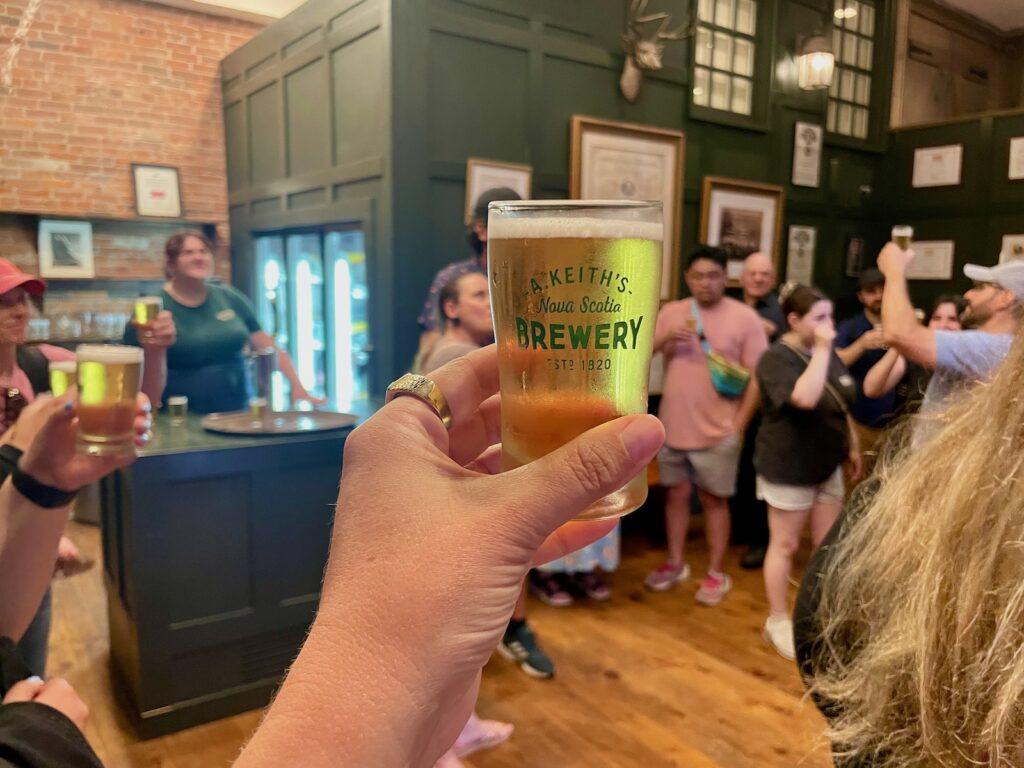
The Split Crow Pub
You may be asking yourself, “A pub? On an itinerary of historical Halifax?” But hear me out! The Split Crow Pub is touted as the oldest tavern in Halifax, and has a history that dates back to 1749. So go and have a pint there… for history, of course!

Basics about Staying in Halifax
The Westin Nova Scotian is in a fantastic location for exploring downtown Halifax; many of Halifax’s most famous spots are within a short walking distance. There are plenty of other hotels within the city – you’ll find cheaper options the further you get from downtown – but this hotel is my top pick.
I used a rental car from Hertz to get around Halifax, although the city also has public buses, taxis, and rideshare options such as Uber. If you want to explore outside the city, including a visit to York Redoubt, I recommend getting a rental car; I found it incredibly easy to drive around Halifax.
Halifax has many excellent restaurants, and you’re never far from a quality meal! I especially enjoyed my meals at The Bicycle Thief and Black Sheep (reservations are recommended for both). There are many great places to eat along the waterfront, including many street food stalls.
Have you been to Halifax? What would you add to this historical itinerary?
Many thanks to Tourism Nova Scotia for hosting me on this trip. All opinions – as always! – are completely my own.


12 comments
A very informative post – thank you, Brenna. PS: happy to see you post on the blog – really missed that 🙂
Aw, thank you very much, Alina!
I’ve been thinking about going to Halifax for a while and a few of these things are right up my alley (soldier for a day is too funny, my hubby and I need to do it lol). Thanks for the tips!
It was so much fun! I hope you get to Halifax very soon, I’m sure you’d love it 🙂
Great article! Thanks for the advice, I need to go back to Halifax.
Thank you, Kerry! I hope you get back to Halifax soon 🙂
Thanks for putting this together! I went to Halifax when I was a teenager and remember the Citadel, but this post makes me want to go back to the city. I saw on instagram that your mom was able to join, that’s awesome.
Thanks, Charlotte! It was such a fun trip, I hope you’re able to go back soon 🙂
Very informative, thank you 🙂
I’m glad it was helpful, Denise!
What an amazing post, Brenna! You’ve really given readers a wonderful taste of all there is to see, hear, taste, and experience in general in this beautiful little city on the sea. And I love your smile in all the photos: it’s clear you’re excited to be back in your former “home for a while”.
Thank you so much, mama, I’m so glad that you were able to join for a bit!